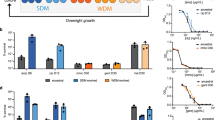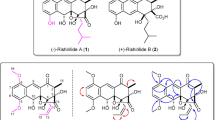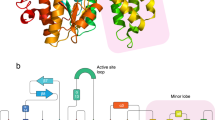Abstract
Carbapenems, a family of β-lactam antibiotics, are among the most powerful bactericidal compounds in clinical use. However, as rational engineering of native carbapenem-producing microbes is not currently possible, the present carbapenem supply relies upon total chemical synthesis of artificial carbapenem derivatives. To enable access to the full diversity of natural carbapenems, we have engineered production of a simple carbapenem antibiotic within Escherichia coli. By increasing concentrations of precursor metabolites and identifying a reducing cofactor of a bottleneck enzyme, we improved productivity by 60-fold over the minimal pathway and surpassed reported titers obtained from carbapenem-producing Streptomyces species. We stabilized E. coli metabolism against antibacterial effects of the carbapenem product by artificially inhibiting membrane synthesis, which further increased antibiotic productivity. As all known naturally occurring carbapenems are derived from a common intermediate, our engineered strain provides a platform for biosynthesis of tailored carbapenem derivatives in a genetically tractable and fast-growing species.
This is a preview of subscription content, access via your institution
Access options
Access Nature and 54 other Nature Portfolio journals
Get Nature+, our best-value online-access subscription
$29.99 / 30 days
cancel any time
Subscribe to this journal
Receive 12 print issues and online access
$259.00 per year
only $21.58 per issue
Buy this article
- Purchase on Springer Link
- Instant access to full article PDF
Prices may be subject to local taxes which are calculated during checkout




Similar content being viewed by others
References
Gillespie, D. E. et al. Isolation of antibiotics turbomycin a and B from a metagenomic library of soil microbial DNA. Appl. Environ. Microbiol. 68, 4301–4306 (2002).
Ling, L. L. et al. A new antibiotic kills pathogens without detectable resistance. Nature 517, 455–459 (2015).
Rutledge, P. J. & Challis, G. L. Discovery of microbial natural products by activation of silent biosynthetic gene clusters. Nat. Rev. Microbiol. 13, 509–523 (2015).
Brady, S. F., Simmons, L., Kim, J. H. & Schmidt, E. W. Metagenomic approaches to natural products from free-living and symbiotic organisms. Nat. Prod. Rep. 26, 1488–1503 (2009).
Olano, C., Lombó, F., Méndez, C. & Salas, J. A. Improving production of bioactive secondary metabolites in actinomycetes by metabolic engineering. Metab. Eng. 10, 281–292 (2008).
Katz, L. & Khosla, C. Antibiotic production from the ground up. Nat. Biotechnol. 25, 428–429 (2007).
Demain, A. L. From natural products discovery to commercialization: a success story. J. Ind. Microbiol. Biotechnol. 33, 486–495 (2006).
Medema, M. H., Breitling, R., Bovenberg, R. & Takano, E. Exploiting plug-and-play synthetic biology for drug discovery and production in microorganisms. Nat. Rev. Microbiol. 9, 131–137 (2011).
Awan, A. R. et al. Biosynthesis of the antibiotic nonribosomal peptide penicillin in baker’s yeast. Nat. Commun. 8, 15202 (2017).
Freeman, M. F., Vagstad, A. L. & Piel, J. Polytheonamide biosynthesis showcasing the metabolic potential of sponge-associated uncultivated ‘Entotheonella’ bacteria. Curr. Opin. Chem. Biol. 31, 8–14 (2016).
Hamed, R. B., Henry, L., Claridge, T. D. W. & Schofield, C. J. Stereoselective production of dimethyl-substituted carbapenams via engineered carbapenem biosynthesis enzymes. ACS Catal. 7, 1279–1285 (2017).
Zhang, H., Wang, Y., Wu, J., Skalina, K. & Pfeifer, B. A. Complete biosynthesis of erythromycin A and designed analogs using E. coli as a heterologous host. Chem. Biol. 17, 1232–1240 (2010).
McKenna, M. Antibiotic resistance: the last resort. Nature 499, 394–396 (2013).
Papp-Wallace, K. M., Endimiani, A., Taracila, M. A. & Bonomo, R. A. Carbapenems: past, present, and future. Antimicrob. Agents Chemother. 55, 4943–4960 (2011).
Wei, W. J., Yang, H. F., Ye, Y. & Li, J. B. Bin. New Delhi metallo-beta-lactamase-mediated carbapenem resistance: Origin, diagnosis, treatment and public health concern. Chin. Med. J. (Engl.) 128, 1969–1976 (2015).
Kahan, J. S. et al. Thienamycin, a new beta-lactam antibiotic. I. Discovery, taxonomy, isolation and physical properties. J. Antibiot. (Tokyo) 32, 1–12 (1979).
Hamed, R. B. et al. The enzymes of β-lactam biosynthesis. Nat. Prod. Rep. 30, 21–107 (2013).
Coulthurst, S. J., Barnard, A. M. L. & Salmond, G. P. C. Regulation and biosynthesis of carbapenem antibiotics in bacteria. Nat. Rev. Microbiol. 3, 295–306 (2005).
McGowan, S. J. et al. Analysis of bacterial carbapenem antibiotic production genes reveals a novel beta-lactam biosynthesis pathway. Mol. Microbiol. 22, 415–426 (1996).
Pfaendler, H. R., Gosteli, J., Woodward, R. B. & Rihs, G. Structure, reactivity, and biological activity of strained bicyclic β-lactams. J. Am. Chem. Soc. 103, 4526–4531 (1981).
McGowan, S. J. et al. Analysis of the carbapenem gene cluster of Erwinia carotovora: definition of the antibiotic biosynthetic genes and evidence for a novel β-lactam resistance mechanism. Mol. Microbiol. 26, 545–556 (1997).
van Vugt-Lussenburg, B. M., van der Weel, L., Hagen, W. R. & Hagedoorn, P. L. Biochemical similarities and differences between the catalytic [4Fe-4S] cluster containing fumarases FumA and FumB from Escherichia coli. PLoS One 8, e55549 (2013).
McHugh, J. P. et al. Global iron-dependent gene regulation in Escherichia coli. A new mechanism for iron homeostasis. J. Biol. Chem. 278, 29478–29486 (2003).
Stiefel, E. I. & George, G. N. in Bioinorganic Chemistry (eds. Bertini, I., Gray, H.B., Lippard, S.J. & Valentine, J.S.) Ch. 7 (University Science Books, Mill Valley, CA, 1994).
Altschul, S. F., Gish, W., Miller, W., Myers, E. W. & Lipman, D. J. Basic local alignment search tool. J. Mol. Biol. 215, 403–410 (1990).
Gerratana, B., Stapon, A. & Townsend, C. A. Inhibition and alternate substrate studies on the mechanism of carbapenam synthetase from Erwinia carotovora. Biochemistry 42, 7836–7847 (2003).
Stapon, A., Li, R. & Townsend, C. A. Carbapenem biosynthesis: confirmation of stereochemical assignments and the role of CarC in the ring stereoinversion process from L-proline. J. Am. Chem. Soc. 125, 8486–8493 (2003).
Chang, W. C. et al. Mechanism of the C5 stereoinversion reaction in the biosynthesis of carbapenem antibiotics. Science 343, 1140–1144 (2014).
Pérez-Arellano, I., Carmona-Álvarez, F., Gallego, J. & Cervera, J. Molecular mechanisms modulating glutamate kinase activity. Identification of the proline feedback inhibitor binding site. J. Mol. Biol. 404, 890–901 (2010).
Korch, S. B. & Hill, T. M. Ectopic overexpression of wild-type and mutant hipA genes in Escherichia coli: effects on macromolecular synthesis and persister formation. J. Bacteriol. 188, 3826–3836 (2006).
Bokinsky, G. et al. HipA-triggered growth arrest and β-lactam tolerance in Escherichia coli are mediated by RelA-dependent ppGpp synthesis. J. Bacteriol. 195, 3173–3182 (2013).
Heath, R. J., Jackowski, S. & Rock, C. O. Guanosine tetraphosphate inhibition of fatty acid and phospholipid synthesis in Escherichia coli is relieved by overexpression of glycerol-3-phosphate acyltransferase (plsB). J. Biol. Chem. 269, 26584–26590 (1994).
Rodionov, D. G. & Ishiguro, E. E. Dependence of peptidoglycan metabolism on phospholipid synthesis during growth of Escherichia coli. Microbiology 142, 2871–2877 (1996).
Omura, S. The antibiotic cerulenin, a novel tool for biochemistry as an inhibitor of fatty acid synthesis. Bacteriol. Rev. 40, 681–697 (1976).
Rogers, J. K. & Church, G. M. Genetically encoded sensors enable real-time observation of metabolite production. Proc. Natl Acad. Sci. USA 113, 2388–2393 (2016).
Yang, Y., Lin, Y., Li, L., Linhardt, R. J. & Yan, Y. Regulating malonyl-CoA metabolism via synthetic antisense RNAs for enhanced biosynthesis of natural products. Metab. Eng. 29, 217–226 (2015).
Fehér, T., Libis, V., Carbonell, P. & Faulon, J.-L. A sense of balance: experimental investigation and modeling of a malonyl-CoA sensor in Escherichia coli. Front. Bioeng. Biotechnol. 3, 46 (2015).
Cameron, D. E. & Collins, J. J. Tunable protein degradation in bacteria. Nat. Biotechnol. 32, 1276–1281 (2014).
Rosi, D. et al. Mutants of Streptomyces cattleya producing N-acetyl and deshydroxy carbapenems related to thienamycin. J. Antibiot. (Tokyo) 34, 341–343 (1981).
Wilson, K. E., Kempf, A. J., Liesch, J. M. & Arison, B. H. Northienamycin and 8-epi-thienamycin, new carbapenems from Streptomyces cattleya. J. Antibiot. (Tokyo) 36, 1109–1117 (1983).
Wagman, G. H. & Cooper, R. Natural Products Isolation: Separation Methods for Antimicrobials, Antivirals and Enzyme Inhibitors (Elsevier Science, New York, 1988).
Bateson, J. H., Baxter, A. J. G., Roberts, P. M., Smale, T. C. & South-Gate, R. Olivanic acid analogues. Part 1. Total synthesis of the 7-oxo-1-azabicyclo[3.2.0]hept-2-ene-2-carboxylate system and some related β-lactams. J. Chem. Soc. Perkin Trans. I 1981, 3242–3249 (1981).
Zabala, D., Braña, A. F., Flórez, A. B., Salas, J. A. & Méndez, C. Engineering precursor metabolite pools for increasing production of antitumor mithramycins in Streptomyces argillaceus. Metab. Eng. 20, 187–197 (2013).
Gómez, C. et al. Amino acid precursor supply in the biosynthesis of the RNA polymerase inhibitor streptolydigin by Streptomyces lydicus. J. Bacteriol. 193, 4214–4223 (2011).
Zhang, M. M., Wang, Y., Ang, E. L. & Zhao, H. Engineering microbial hosts for production of bacterial natural products. Nat. Prod. Rep. 33, 963–987 (2016).
Marous, D. R. et al. Consecutive radical S-adenosylmethionine methylations form the ethyl side chain in thienamycin biosynthesis. Proc. Natl Acad. Sci. USA 112, 10354–10358 (2015).
Kirby, J. et al. Engineering a functional 1-deoxy-d-xylulose 5-phosphate (DXP) pathway in Saccharomyces cerevisiae. Metab. Eng. 38, 494–503 (2016).
Tuomanen, E. Phenotypic tolerance: the search for β-lactam antibiotics that kill nongrowing bacteria. Rev. Infect. Dis. 8 (Suppl. 3), S279–S291 (1986).
Briand, L. et al. A self-inducible heterologous protein expression system in Escherichia coli. Sci. Rep. 6, 33037 (2016).
Neidhardt, F. C., Bloch, P. L. & Smith, D. F. Culture medium for enterobacteria. J. Bacteriol. 119, 736–747 (1974).
Gibson, D. G. et al. Enzymatic assembly of DNA molecules up to several hundred kilobases. Nat. Methods 6, 343–345 (2009).
Lee, T. S. et al. BglBrick vectors and datasheets: A synthetic biology platform for gene expression. J. Biol. Eng. 5, 12 (2011).
Hagen, W. R. Biomolecular EPR Spectroscopy. CRC Press. (CRC Press, Boca Raton, 2008).
Bradford, M. M. A rapid and sensitive method for the quantitation of microgram quantities of protein utilizing the principle of protein-dye binding. Anal. Biochem. 72, 248–254 (1976).
Datsenko, K. A. & Wanner, B. L. One-step inactivation of chromosomal genes in Escherichia coli K-12 using PCR products. Proc. Natl Acad. Sci. USA 97, 6640–6645 (2000).
Parker, W. L. et al. SQ 27,860, a simple carbapenem produced by species of Serratia and Erwinia. J. Antibiot. (Tokyo) 35, 653–660 (1982).
Acknowledgements
We thank D.E. Cameron and J.J. Collins (Massachusetts Institute of Technology) for the gift of strains for designing tunable protein degradation. We are grateful to V. Libis (Rockefeller University) for the gift of the plasmid pCFR. We thank F. Wu for valuable scientific discussions throughout the project and B. Beaumont for helpful comments with the manuscript. This work was supported by startup funds provided to G.B. from TU Delft and the Department of Bionanoscience, as well as the Netherlands Organization for Scientific Research (NWO/OCW), as part of the Frontiers of Nanoscience program. P.-L.H. was supported by grant NWO–CW 711.014.006 from the Council for Chemical Sciences of the NWO.
Author information
Authors and Affiliations
Contributions
G.B. and H.S. designed the experiments. H.S. performed the experiments and analyzed the results. S.G. constructed strains and performed experiments for studying the function of CarE. H.T.M. performed preliminary experiments to study FAS inhibition. P.-L.H. conducted EPR spectroscopy and analyzed related data. H.S. and N.v.d.B. developed LC–MS methods, with early assistance from M.J.N. G.B. supervised the research. H.S. and G.B. wrote the manuscript.
Corresponding author
Ethics declarations
Competing interests
G.B. and H.S. have filed a patent application covering metabolic engineering of carbapenem pathways.
Additional information
Publisher’s note: Springer Nature remains neutral with regard to jurisdictional claims in published maps and institutional affiliations.
Supplementary information
Supplementary Text and Figures
Supplementary Figures 1–13, Supplementary Tables 1–4
Rights and permissions
About this article
Cite this article
Shomar, H., Gontier, S., van den Broek, N.J.F. et al. Metabolic engineering of a carbapenem antibiotic synthesis pathway in Escherichia coli. Nat Chem Biol 14, 794–800 (2018). https://doi.org/10.1038/s41589-018-0084-6
Received:
Accepted:
Published:
Issue Date:
DOI: https://doi.org/10.1038/s41589-018-0084-6
This article is cited by
-
Ecology and genomics of Actinobacteria: new concepts for natural product discovery
Nature Reviews Microbiology (2020)
-
Metalloprotein switches that display chemical-dependent electron transfer in cells
Nature Chemical Biology (2019)
-
Cascade biocatalysis systems for bioactive naringenin glucosides and quercetin rhamnoside production from sucrose
Applied Microbiology and Biotechnology (2019)
-
Biosynthesis of organic photosensitizer Zn-porphyrin by diphtheria toxin repressor (DtxR)-mediated global upregulation of engineered heme biosynthesis pathway in Corynebacterium glutamicum
Scientific Reports (2018)



